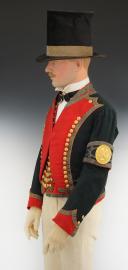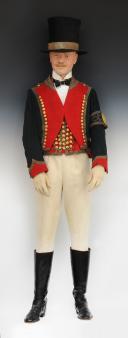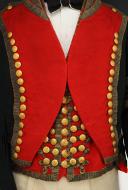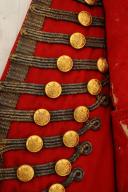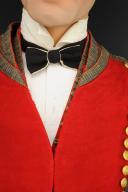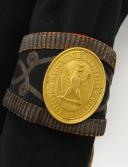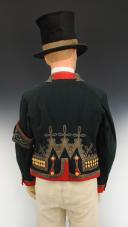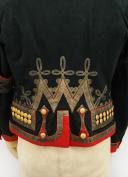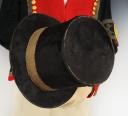
MANNEQUIN FROM THE EMPEROR'S HOUSEHOLD IN STABLE UNIFORM, POST SERVICE, Second Empire. 29233
MANNEQUIN OF THE EMPEROR'S HOUSE CREW IN DUTY UNIFORM, STABLE SERVICE, Second Empire. 29233
TOP HAT made of black taupe felt-covered cardboard. H 19.5 cm. A 5 cm high silver-gilt braid is sewn at the base of the hat. Interior crown composed of a 7 cm high ocher calf band. Grey paper lining, crown interior lining in black printed cardboard "GN" and "5 1/2", hot stamped "68" "STABLE SERVICE" topped with an imperial crown. Good condition.
WAISTCOAT in scarlet cloth entirely braided in gold with horizontal side pockets. The front sides are adorned with fifteen gold braids, eight of which at the bottom form buttonholes on each side. The left side braids are decorated with two half-rounded gilded metal buttons stamped with the Imperial Arms, diameter 1.5 cm. The right side is adorned with three rows of buttons. Waistcoat lined with white canvas. Waistcoat marked "THIBAULT stable service" dated from the 2nd quarter of 1870. Very good condition.
COAT in dark green cloth with a scarlet cloth plastron braided in gold bordered on each side by 17 half-rounded gilded metal uniform buttons stamped with the Imperial Arms, diameter 1.5 cm. The plastrons are closed with a gilded brass hook. Scarlet cloth collar braided in gold, H 4 cm, with gold piping forming scrolls. Scarlet cloth pointed front facings, braided in gold, with two uniform buttons on each side. Waist knot adorned with a gold braid forming three points, highlighted at the top with a gold passementerie trim forming scrolls and a Hungarian knot. Straight scarlet cloth cuffs braided in gold. On each side of the cuffs, a false scarlet cloth galligaskins with two uniform buttons. Horizontal false rear pockets in dark green cloth piped in scarlet, braided in gold, adorned with 13 buttons spread over two rows. Lining in scarlet cloth and white canvas. Marked "THIBAULT stable service" dated from the 2nd quarter of 1870. Very good condition.
ARMBAND in dark green cloth edged in scarlet at the top and bottom, braided in gold, and adorned with a gold soutache forming scrolls and a Hungarian knot. It attaches with two metal clasps. In the middle, an oval brass plaque is sewn, stamped with a crowned imperial eagle surrounded by a molding bearing the inscription "EMPEROR'S HOUSE / STABLE SERVICE", H 8 cm, width 6.5 cm. Scarlet cloth lining. Very good condition.
WHITE SHIRT in good condition.
BOW TIE in black silk underlined with white silk. Good condition.
WHITE KID GLOVES, marked "stable service" and dated from the 2nd quarter of 1868. Very good condition.
BREECHES Ponte Breeches in white kid with ivory-colored bone buttons, marked "stable service" and dated from the 2nd quarter of 1868. Very good condition.
PAIR OF BLACK LEATHER BOOTS. Boot height 40 cm. Very good condition.
PROVENANCE: Former collection of Charles Marchal, then Mr. Michaud, and François Coquard.
NOTE: This ensemble is complete and perfectly homogeneous, which is very rare.
HISTORY: The Emperor's house brings together the officers, servants, and civilian staff serving the private and domestic needs of Emperor Napoleon I. A symbol of his independence and assurance of power, it organizes the court's daily life around him in the palaces and during the reign's major events, ensures compliance with etiquette, and manages the Crown's domain. A true "State within the State," it will constitute around Napoleon, throughout his reign, a final golden wall, even in 1814 when the marshals and ministers falter. It is inspired by the King's house that existed under the Ancien Régime until 1792. Thus, Napoleon recreates the pages' house, the great almonry, and the hunt, quintessentially monarchic activities that add splendor to his reign, even though by his own admission, he had no interest in religion and no talent for hunting.
THE STABLES The service of the grand equerry, General Armand de Caulaincourt, includes a first equerry, General Nansouty, a grand officer of cavalry of the First Empire, and about ten equerries. Between 1807 and 1811, when Caulaincourt was appointed the Emperor's ambassador to Russia, it was Nansouty who daily assumed the duties of grand equerry. The grand equerry is responsible for the sovereign's schedule, organizing his travels and security on both journeys and in field bivouacs. Apart from lodging and meals, everything related to the Emperor's travels falls under his authority. He designates the men, carriages, and horses, notably. Like the grand marshal of the palace, the grand equerry permanently accompanies Napoleon. He guards the Emperor's weapons, follows him closely on foot or horseback, and helps him over steep passages. He assists the Emperor in mounting his horse and hands him his whip and reins. If his mount falls, he helps it up; if it is killed, he gives him his own. The grand equerry commands the stables of Saint-Cloud and oversees the messengers, estafettes, and dispatches of the Emperor's household. He also supervises the education of the thirty pages assigned to the Emperor's service, surrounded by a governor and teachers.
THE IMPERIAL EQUESTRIAN CARRIAGES UNDER NAPOLEON III Text: by Mr. Henri Baup
When elected President of the Republic on December 12, 1848, Louis Napoleon Bonaparte became the Prince President, and four years later, the Second Empire was proclaimed, he would be called Napoleon III. When he came to power, he found, in the National Palace stables, at the Louvre, at the Trianon in Versailles, at the Tuileries, numerous service or grand gala carriages that had belonged to his predecessors (Napoleon I (1814); Louis XVIII (1815); Charles X (1824); Louis Philippe (1848)) and some of which were restored at great expense and used for exceptional occasions. Part of the service staff had remained in place after the departure of the former masters. Quickly, new carriages (especially berlines) and new harnesses necessary for the Court's service were ordered from the great Parisian carriage and saddlemakers: Ehrler, Brune, Roduwart (for the harness)... The task of reorganizing the stables and the carriage service was entrusted to the Grand Equerry, General Count Emile Fleury, who was joined by one of his former ordnance officers, General Baron Faverot de Kerbrech, himself assisted by the head groom Henri Thuillier, who throughout the Second Empire remained in charge of the team service, organizing the composition, choosing horses, carriages, and harness according to the rules of French service or in d'Aumont that he had learned in the king's service Louis Philippe and Charles X. Very quickly, under the impulse of these men of art, the Imperial Stables gained a universal reputation for perfection and supreme elegance. It will later be said that the Second Empire was truly the golden age of luxury horse carriages.
...
THE END OF THE IMPERIAL STABLES
In 1881, as President of the Council, Gambetta created a Ministry of Fine Arts for his friend Antonin Proust, which would be installed at the Louvre. To create offices, it was decided to free up the stables. The Empress then had to take back the carriages and harnesses belonging to her and had them brought to Farnborough Hill (Hampshire), where she lived in seclusion, the grand gala carriage with seven mirrors and an eight-horse harness. Two public auctions of a number of carriages were made (we will report on them later); the grand gala carriages remained at Trianon.
The golden age of large luxury carriages was over.
TOP HAT made of black taupe felt-covered cardboard. H 19.5 cm. A 5 cm high silver-gilt braid is sewn at the base of the hat. Interior crown composed of a 7 cm high ocher calf band. Grey paper lining, crown interior lining in black printed cardboard "GN" and "5 1/2", hot stamped "68" "STABLE SERVICE" topped with an imperial crown. Good condition.
WAISTCOAT in scarlet cloth entirely braided in gold with horizontal side pockets. The front sides are adorned with fifteen gold braids, eight of which at the bottom form buttonholes on each side. The left side braids are decorated with two half-rounded gilded metal buttons stamped with the Imperial Arms, diameter 1.5 cm. The right side is adorned with three rows of buttons. Waistcoat lined with white canvas. Waistcoat marked "THIBAULT stable service" dated from the 2nd quarter of 1870. Very good condition.
COAT in dark green cloth with a scarlet cloth plastron braided in gold bordered on each side by 17 half-rounded gilded metal uniform buttons stamped with the Imperial Arms, diameter 1.5 cm. The plastrons are closed with a gilded brass hook. Scarlet cloth collar braided in gold, H 4 cm, with gold piping forming scrolls. Scarlet cloth pointed front facings, braided in gold, with two uniform buttons on each side. Waist knot adorned with a gold braid forming three points, highlighted at the top with a gold passementerie trim forming scrolls and a Hungarian knot. Straight scarlet cloth cuffs braided in gold. On each side of the cuffs, a false scarlet cloth galligaskins with two uniform buttons. Horizontal false rear pockets in dark green cloth piped in scarlet, braided in gold, adorned with 13 buttons spread over two rows. Lining in scarlet cloth and white canvas. Marked "THIBAULT stable service" dated from the 2nd quarter of 1870. Very good condition.
ARMBAND in dark green cloth edged in scarlet at the top and bottom, braided in gold, and adorned with a gold soutache forming scrolls and a Hungarian knot. It attaches with two metal clasps. In the middle, an oval brass plaque is sewn, stamped with a crowned imperial eagle surrounded by a molding bearing the inscription "EMPEROR'S HOUSE / STABLE SERVICE", H 8 cm, width 6.5 cm. Scarlet cloth lining. Very good condition.
WHITE SHIRT in good condition.
BOW TIE in black silk underlined with white silk. Good condition.
WHITE KID GLOVES, marked "stable service" and dated from the 2nd quarter of 1868. Very good condition.
BREECHES Ponte Breeches in white kid with ivory-colored bone buttons, marked "stable service" and dated from the 2nd quarter of 1868. Very good condition.
PAIR OF BLACK LEATHER BOOTS. Boot height 40 cm. Very good condition.
PROVENANCE: Former collection of Charles Marchal, then Mr. Michaud, and François Coquard.
NOTE: This ensemble is complete and perfectly homogeneous, which is very rare.
HISTORY: The Emperor's house brings together the officers, servants, and civilian staff serving the private and domestic needs of Emperor Napoleon I. A symbol of his independence and assurance of power, it organizes the court's daily life around him in the palaces and during the reign's major events, ensures compliance with etiquette, and manages the Crown's domain. A true "State within the State," it will constitute around Napoleon, throughout his reign, a final golden wall, even in 1814 when the marshals and ministers falter. It is inspired by the King's house that existed under the Ancien Régime until 1792. Thus, Napoleon recreates the pages' house, the great almonry, and the hunt, quintessentially monarchic activities that add splendor to his reign, even though by his own admission, he had no interest in religion and no talent for hunting.
THE STABLES The service of the grand equerry, General Armand de Caulaincourt, includes a first equerry, General Nansouty, a grand officer of cavalry of the First Empire, and about ten equerries. Between 1807 and 1811, when Caulaincourt was appointed the Emperor's ambassador to Russia, it was Nansouty who daily assumed the duties of grand equerry. The grand equerry is responsible for the sovereign's schedule, organizing his travels and security on both journeys and in field bivouacs. Apart from lodging and meals, everything related to the Emperor's travels falls under his authority. He designates the men, carriages, and horses, notably. Like the grand marshal of the palace, the grand equerry permanently accompanies Napoleon. He guards the Emperor's weapons, follows him closely on foot or horseback, and helps him over steep passages. He assists the Emperor in mounting his horse and hands him his whip and reins. If his mount falls, he helps it up; if it is killed, he gives him his own. The grand equerry commands the stables of Saint-Cloud and oversees the messengers, estafettes, and dispatches of the Emperor's household. He also supervises the education of the thirty pages assigned to the Emperor's service, surrounded by a governor and teachers.
THE IMPERIAL EQUESTRIAN CARRIAGES UNDER NAPOLEON III Text: by Mr. Henri Baup
When elected President of the Republic on December 12, 1848, Louis Napoleon Bonaparte became the Prince President, and four years later, the Second Empire was proclaimed, he would be called Napoleon III. When he came to power, he found, in the National Palace stables, at the Louvre, at the Trianon in Versailles, at the Tuileries, numerous service or grand gala carriages that had belonged to his predecessors (Napoleon I (1814); Louis XVIII (1815); Charles X (1824); Louis Philippe (1848)) and some of which were restored at great expense and used for exceptional occasions. Part of the service staff had remained in place after the departure of the former masters. Quickly, new carriages (especially berlines) and new harnesses necessary for the Court's service were ordered from the great Parisian carriage and saddlemakers: Ehrler, Brune, Roduwart (for the harness)... The task of reorganizing the stables and the carriage service was entrusted to the Grand Equerry, General Count Emile Fleury, who was joined by one of his former ordnance officers, General Baron Faverot de Kerbrech, himself assisted by the head groom Henri Thuillier, who throughout the Second Empire remained in charge of the team service, organizing the composition, choosing horses, carriages, and harness according to the rules of French service or in d'Aumont that he had learned in the king's service Louis Philippe and Charles X. Very quickly, under the impulse of these men of art, the Imperial Stables gained a universal reputation for perfection and supreme elegance. It will later be said that the Second Empire was truly the golden age of luxury horse carriages.
...
THE END OF THE IMPERIAL STABLES
In 1881, as President of the Council, Gambetta created a Ministry of Fine Arts for his friend Antonin Proust, which would be installed at the Louvre. To create offices, it was decided to free up the stables. The Empress then had to take back the carriages and harnesses belonging to her and had them brought to Farnborough Hill (Hampshire), where she lived in seclusion, the grand gala carriage with seven mirrors and an eight-horse harness. Two public auctions of a number of carriages were made (we will report on them later); the grand gala carriages remained at Trianon.
The golden age of large luxury carriages was over.
Price :
15 000,00 €
| Destination | Envoi recommandé | Envoi Recommandé + Express |
|---|---|---|
| Shipping France | 30,00 € | 130,00 € |
| Shipping Europe | 60,00 € | 200,00 € |
| Shipping world | 180,00 € | 350,00 € |
Insurance (1%) :
150,00 €
Reference :
29233 Proantic instagram
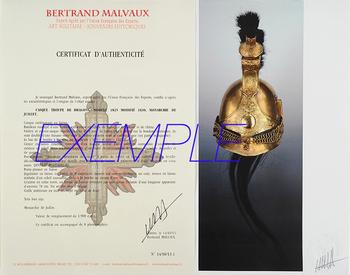
Next update Friday, april 4th at 1:30 PM
FOR ALL PURCHASES, PAYMENT IN MULTIPLE CHECKS POSSIBLE
bertrand.malvaux@wanadoo.fr 06 07 75 74 63
An authenticity certificate of the item including the description published on the site, the period, the sale price, accompanied by one or more color photographs is automatically provided for any item priced over 130 euros. Below this price, each certificate is charged 5 euros.
Only items sold by me are subject to an authenticity certificate, I do not provide any expert reports for items sold by third parties (colleagues or collectors).
